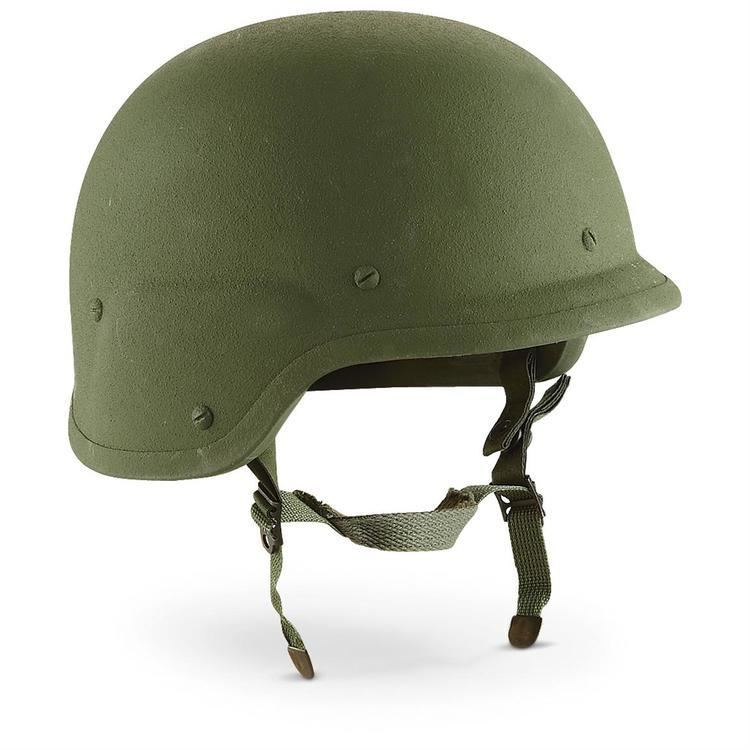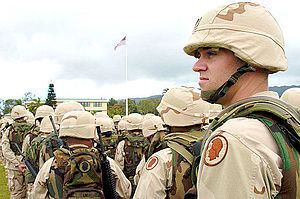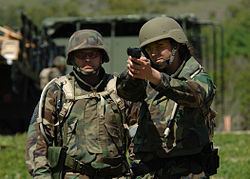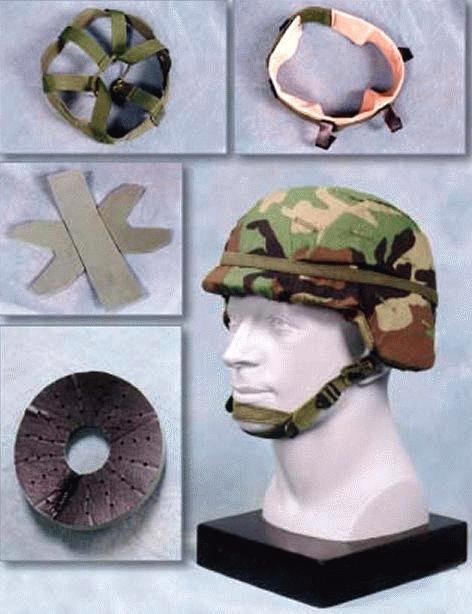 | ||
Level iiia pasgt ballistic combat helmet
Personnel Armor System for Ground Troops (PASGT; pronounced PAZ-get) is a combat helmet and ballistic vest that was used by the United States military from the early-1980s until the mid-2000s, when the helmet and vest were succeeded by the Lightweight Helmet, Modular Integrated Communications Helmet, and Interceptor body armor.
Contents
- Level iiia pasgt ballistic combat helmet
- Name
- Helmet
- Overview
- Development
- Accessories
- Replacement
- Usage by civilians
- Vest
- Accessories and usage
- Military
- Civilian law enforcement
- References

Name

PASGT is an acronym, standing for Personnel Armor System for Ground Troops. When used by itself, PASGT refers to both the vest and helmet together.

In the U.S. military, the PASGT helmet was most commonly known by its wearers as simply the "Kevlar". The nickname has since been adopted for usage with other helmets. The PASGT helmet was also referred to by its wearers in the U.S. military as the "K-pot", similar in name to the colloquial nickname "steel pot" for the steel M1 helmet, which was in widespread U.S. military usage from the 1940s, to the 1970s, including the Vietnam War. The PASGT helmet was also, but less commonly, known by its wearers as the "Fritz" helmet for its resemblance to the Stahlhelm, which was the standard helmet used by the German military forces in the First and Second World Wars.

On the other hand, the PASGT vest was colloquially known as the "flak vest" by its wearers in the U.S. military.
Helmet

The Personnel Armor System for Ground Troops Helmet is a combat helmet first employed by the U.S. military in 1985 and eventually adopted by many other military and law enforcement agencies internationally. The shell is made from 19 layers of Kevlar, a ballistic aramid fabric treated with a phenolic resin system and is rated at a Threat Level IIIA as per DARPA, USMC, and U.S. Army and offers protection against shrapnel and ballistic threats. It meets the 1800 requirement of MIL-STD-662 E. It weighs from 3.1 lb (1,410 g) (size extra small) to 4.2 lb (1,910 g) (extra large).
Overview

The PASGT helmet is typically olive drab in color and can be fitted with cloth helmet covers, which come in a wide array of varying camouflage patterns, including, but not limited to, Woodland, six-color desert, three-color desert, and winter/snow white, solid black, for tactical police applications, as well as the U.S. Marine Corps's MARPAT and the U.S. Army's Universal Camouflage Pattern.
The PASGT helmet is also used by various SWAT teams, where it is often black in color, with or without covering. It is also used by United Nations Peacekeeping forces where it is often painted United Nations blue to match the colors of the United Nations flag.
When worn with a helmet cover, the PASGT helmet is also often fitted with a band around it that has two light recharging glow patches (sometimes known as cat eyes) on the rear intended to reduce friendly fire incidents. These bands are also used to hold vegetation or small personal items, as with the M1 helmet before it, during the later decades of its service life. These bands can also have names and/or ABO blood types printed on them to help identify the blood type the wearer in case a blood transfusion is required as a result of blood loss due to wounds received on the battlefield. In the U.S. Army, PASGT helmets often featured a patch with the wearer's rank insignia on it stitched onto the front, and/or a second patch showing the symbol of the wearer's unit on the sides.
Development
The PASGT helmet was developed after the Vietnam War in 1975 and replaced the steel M1 helmet in U.S. military service during the 1980s. It first saw use in combat in 1983 during Operation Urgent Fury in Grenada, and became standard issue for the U.S. military in 1985, and completely replaced the M1 helmet for frontline troops by the end of the decade. Soldiers stationed in Alaska were some of the last to receive the helmets, some not getting the PASGT until 1988.
Accessories
There are various available add-on accessories for the PASGT helmet, including:-
Replacement
The PASGT helmet was replaced in U.S. military service by the Lightweight Helmet for the U.S. Marine Corps and the Modular Integrated Communications Helmet by the U.S. Army, which was in turn replaced by the Advanced Combat Helmet, which the U.S. Army currently uses.
Both the U.S. Marine Corps and the U.S. Army are looking at yet another helmet replacement for their PASGT helmet successors: the Enhanced Combat Helmet (ECH) with distribution to start in 2014.
However, the PASGT system is still used by some U.S. allies and still sees some continued limited use in the U.S. military as of the mid-2010s, where it serves as one of various helmets and vests for sailors assigned to duty on board U.S. Navy vessels.
Usage by civilians
The PASGT helmet and its many derivative variants have become popular with civilian news media reporters and journalists reporting from war zones across the world, who will often wear them, should the situation warrant the usage of a helmet. Additionally, private militias also use them from time to time.
Vest
The vest of Personnel Armor System for Ground Troops was the United States military's standard upper torso body armor from the mid-1980s up until the early 2000s (decade), when it was replaced by the Outer Tactical Vest of the Interceptor Body Armor system. The PASGT vest replaced the M-69 Fragmentation Protective Body Armor nylon vest that was used during the Vietnam War, which in turn replaced the M-1952A Fragmentation Protective Body Armor that was used during the Korean War.
The PASGT vest utilized Kevlar for the first time in the United States military's body armor, unlike the ballistic nylon that was used in the models of body armor that preceded it. While generally incapable of stopping rifle bullets, the PASGT vest provided better protection against shrapnel and reduced the severity of injuries from small arms fire when compared to the M-69. Despite its ability to stop pistol rounds, including 9×19mm Parabellum FMJ, the vest was only ever designed or intended to stop small fragments without injury to the user. The PASGT Vest weighed approximately 9 lb (4,080 g), a small increase over the previous model.
Accessories and usage
In order to provide protection against high velocity bullets, the PASGT vest was, in 1996, combined with the Interim Small Arms Protective Overvest (ISAPO) pending the adoption of Interceptor body armor. The ISAPO weighed about 16.5 lb (7,480 g) and consisted of a carrier to hold two protective ceramic plate inserts. A PASGT armor system with overvest weighed more than 25 lb (11,340 g) and was criticized by many U.S. troops as unacceptably cumbersome in combat. The ballistic fill consists of 13 plies of 14 oz. water repellent treated Aramid (Kevlar 29) fabric. The inner and outer cover, shoulder pads and front closure flap of the vest are water repellent treated 8 oz. ballistic nylon cloth.
While phased out as frontline body armor by the start of the Iraq War in 2003, it saw some limited wear and usage by United States military personnel during the early stages of the war, where some U.S. Army soldiers would utilize old PASGT vests as makeshift armor as protection for their vehicles in the absence of purpose-made, designated up-armor kits.
Replacement
The PASGT vest was succeeded in U.S. military service by the Outer Tactical Vest of the Interceptor Body Armor system, which was, in turn, partly replaced by the Modular Tactical Vest, Improved Outer Tactical Vest, and Scalable Plate Carrier. However, the PASGT vest still sees some limited use in the U.S. military as of the mid-2010s, where it serves as one of many vests for sailors assigned to duty on board U.S. Navy vessels.
